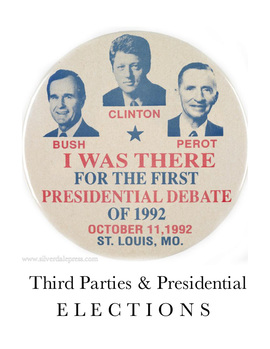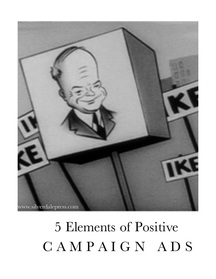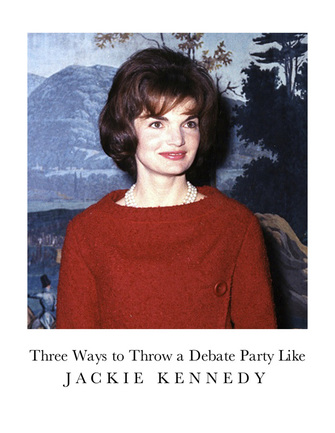 Third parties were in the news this week. The Commission on Presidential Debates, the non-partisan group that makes sure the candidates debate one another, ruled that the third party candidates Gary Johnson and Jill Stein cannot compete in the first debate. The first debate is on September 26, 2016 at Hofstra University in New York. The Commission will allow third parties to compete only if they are legally eligible to be president, are on enough state ballots to win the election, and have at least 15 percent support in five polls. Johnson and Stein met the first two requirements but not the third. The Commission calculated that Johnson was polling at an average of 8.4 percent, while Stein was polling at 3.2 percent. While their campaigns did not have much of a chance, this decision really hurt them. But they can still participate in the final two presidential debates if their support increases in the coming weeks. Johnson is actually doing well for a third party candidate in an American presidential election. He is running as the candidate for the Libertarian Party. He is the first third party candidate since 1996, when H. Ross Perot mounted a successful independent bid, to be on the ballot in all fifty states plus Washington, D.C. Stein is running as the candidate for the Green Party. While she is not doing as well as Johnson, she, as well as Johnson, may impact the outcome of the election in states where the vote will be close. In the 2000 election, for example, Green Party candidate Ralph Nader won 97,421 votes in Florida, the state that decided the election. George W. Bush defeated Al Gore by only 537 votes. The most successful third party candidate in recent history was H. Ross Perot. While he ran and did well in 1996, he also ran in 1992 and won 19 percent of the popular vote. Perot probably could have done even better if he hadn't dropped out of the race and then got back in late in the game. Perot, however, did not get any Electoral College votes. Also, Perot was polling well enough that the Commission allowed him to participate in all three presidential debates! This week, let's take a closer look at third parties. 2016 Exercise Explore the websites for Gary Johnson (Libertarian Party) and Jill Stein (Green Party). What are the candidates' backgrounds, and how did they get into politics? Who are their vice presidential nominees? What issues are important to the third party candidates? How do they differ from the Democratic and Republican candidates? Younger students can then write a few sentences on each question. More advanced students can write a compare and contrast essay of about 500 words in length. Historical Exercises: Watch the town hall debate in 1992 between President George H.W. Bush, Governor Bill Clinton, and Ross Perot. How did the candidates differ from one another? Watch this Perot infomercial from 1992. Based on what you saw, why did so many Americans like Perot? Questions for Debate: Is it fair that Johnson and Stein are being excluded from the first debate in the 2016 campaign? Should third parties be allowed to compete in the presidential debates, no matter how well they are polling? What criteria should third party candidates have to meet to be allowed to compete in the presidential debates? How well do you think the third party candidates will do this year? Do you think they will impact the outcome of the election? Would you vote for one of the third party candidates in 2016? Why or why not?
0 Comments
 You like Ike I like Ike Everybody Likes Ike... for President Hang out the banner and beat the drum We'll take Ike to Washington. These are the words to the catchy jingle of Dwight D. Eisenhower's 1952 campaign advertisement, "Ike for President." You can watch it here. See if you're not singing the tune for the rest of the day! The year 1952 marked the first time television advertisements were used in a presidential election. And they haven't gone out of fashion. They've been filling our airwaves each election season ever since. Television reaches more Americans than any other medium, so campaign ads are a very important part of campaign strategy. I love teaching about campaign ads. If students are bored by the Electoral College and party platforms, they'll sit enraptured watching campaign ads. Students can learn so much from campaign ads, from what leadership image the candidates are trying to get across to the issues that are important in the campaigns. Campaign ads come in two forms: positive and negative. This week, we'll take a look at positive ads. The first televised ads were positive ones; those that aired during the 1950s and early 1960s were cheery and optimistic. Today, campaigns still put out positive ads, though attack ads or negative ads have also become important parts of media strategy. We'll talk about negative ads next week. In positive ads, we see the candidates looking good. They brag about the great things they have done and what kind and generous people they are. Positive ads tell about the candidate’s personal story and values. In positive ads, there is usually pleasant music playing in the background. Pictures of the candidates’ family are flashed on the screen. Candidates often speak directly into the camera. They try to come across as one of the people. The images convey hope. Learning Activity This week, we're going to take a closer look at a positive ad for each of the major party candidates, Republican Donald Trump and Democrat Hillary Clinton. 1. Have your student view this positive ad "Dorothy" from Hillary Clinton and this one called "America Soaring" from Donald Trump. 2. Tell your student there are five main elements in every campaign ad: pictures, sound, words, color, and voices. Re-watch the ads as many times as you need to in order to really soak them in. Consider the following questions. a. Pictures: What positive images are used? How do they portray the candidate in a good light? b. Sound: Is there music in the background? How does it set a positive tone? What about other sounds? c. Words: Does text (printed words) appear on the screen? What positive messages does the text convey? d. Color: How is color used to create a positive message? e. Voices: Whose voices do you hear? How do they sound? How do they make the viewers feel? Students can write out 3-5 sentences on each question. More advanced students can write a 5oo-word essay on "The Five Elements of a Positive Ad," applying the elements to one of the ads. Web Resources The best Website for campaign ads in history is The Living Room Candidate. On this site, you can view campaign ads from 1952 onward. You can find the current candidates' campaign ads and more on their YouTube Channels: Hillary Clinton and Donald J. Trump for President. Historical Exercise Another really fun activity is to go to The Living Room Candidate and pick out one or more positive ads between 1952 and 2012. Then repeat the above exercise on pictures, sound, words, color, and voices. For more resources, exercises and detailed lessons, check out our Presidential Unit Election Study.  Jackie Kennedy was pregnant during her husband’s 1960 presidential campaign. She had difficult pregnancies in the past and could not handle the rigors of the campaign trail. In 1960, the presidential debates were televised for the first time. Television was a new medium, and the debates ushered in a new era in which television dominated electoral politics. Though she was precariously pregnant, Jackie Kennedy still found ways to be useful. To mark the debates, she hosted a series of television “listening parties” at her home in Hyannis Port, Massachusetts. She also invited Americans to ask friends into their own living rooms, imploring them to “Join in the Great Debate.” The Commission on Presidential Debates recently announced the dates for the 2016 presidential debates: September 26, 2016: First presidential debate October 4, 2016: Vice presidential debate October 9, 2016: Second presidential debate October 19, 2016: Third presidential debate Why not plan to gather your family together with friends to watch the presidential debates? You can learn about issues, share reactions, and have fun all at the same time! Need some help in putting together a presidential debate party? Here are three tips from Jackie Kennedy. (Plus, keep reading for a fun and educational document from the JFK Library archives, including related questions to help your student dig into history). 1. Open Your Home Jackie Kennedy provided a warm and personal setting for her debate party: her own home. She could have rented out a nearby reception hall or just had a Democratic committeewoman host it instead. But she didn’t. She felt it was important for her guests to watch the debate in her own living room. Oftentimes, it is easier for us not to open up our homes. Our homes are never in tip-top shape (at least mine isn’t), plus there’s all the cooking and cleaning. Remember that Jackie Kennedy was pregnant. And she was nervous. Much was at stake for her family. In the days leading up to the debate, she said that she “lived in suspense waiting for the great moment and hoping Jack would do well.” To help welcome others into your home, it's always a good idea to serve food. If you’re looking for some fun ideas for presidential debate fare, follow our Patriotic Food and Presidential Food boards on Pinterest. 2. Invite Friends In her “Campaign Wife” newspaper column, Jackie Kennedy said, “I prepared for the first of the great debates…by inviting friends to watch it with me.” Her invite list was Democrats only. But she wrote, “I wanted to hold the first listening party to encourage people around the country to do the same, whether for Kennedy or Nixon.” Take a cue from Jackie Kennedy and be sure to include likeminded people on your own debate party invite list. 3. Make Handouts At Jackie Kennedy’s debate parties, she distributed fact sheets about the four major issues in 1960: peace, education, cost of living, and medical costs for senior citizens. This helped to educate the guests, while nudging them turn out for the party ticket. You too can make fact sheets on important issues of the day: the economy, terrorism, jobs, and others. Check out your candidates’ official websites for their issue positions. Now for the historical document from the Kennedy archives. I dug up this document at the Kennedy Library when I was doing research for my book on first ladies. It is the press release announcing Jackie Kennedy’s first TV-listening party. Have your student read the document and answer these questions:
You can learn more about the presidential debates, including the historic Nixon-Kennedy debate, in our Presidential Elections unit study. |
Silverdale PressCheck out our About Page to learn more about us! Categories |

 RSS Feed
RSS Feed